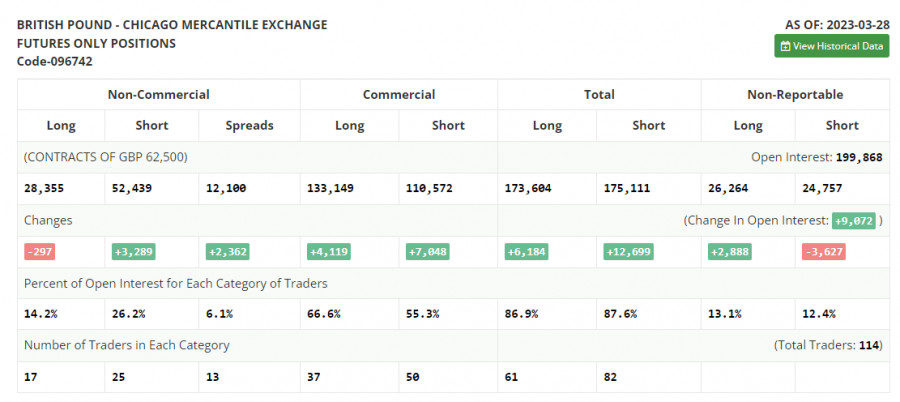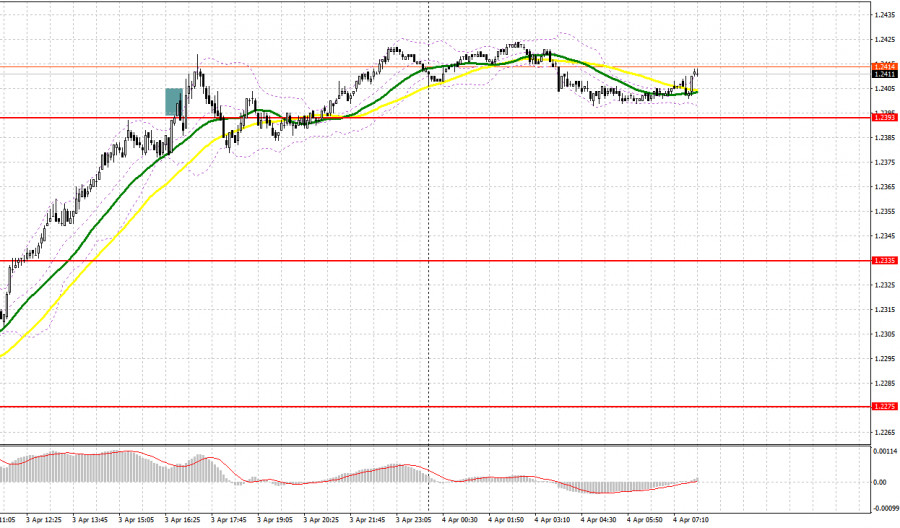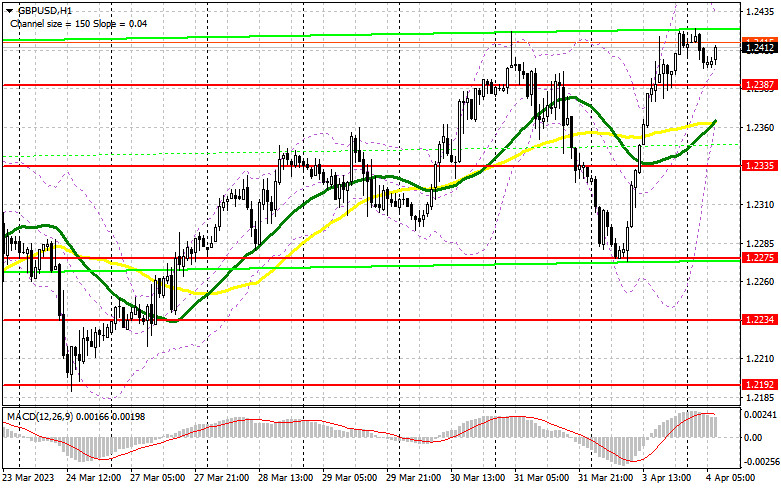
A single entry signal came yesterday. Let's look at the M5 chart to get a picture of what happened. In my previous review, I considered entering the market at 1.2303. The price broke through the mark, but no retest followed. So, I did not go long. In the North American session, a false breakout through 1.2393, which came after a steep rise in GBP/USD, produced what seemed to be a nice sell signal. However, I ended up incurring losses as no decline followed.

When to open long positions on GBP/USD:
Before analyzing the pound from a technical point of view, let's discuss the situation in the futures market. According to the COT report from March 28, long positions decreased and short positions increased. Yet, it was a minor change. Upwardly revised Q4 UK GDP data were enough for the pound to stay firm at monthly highs. Governor Bailey's remarks hinted at more rate hikes coming. The latest COT report revealed that short non-commercial positions increased by 3,289 to 52,439, while long non-commercial positions declined by 297 to 28,355. As a result, the non-commercial net position came in at -20,084 versus -20,498 a week earlier. The weekly closing price climbed to 1.2358 against 1.2241.

Today, the bulls may push the price above the March high. The day will be uneventful with an MPC official speaking only. Therefore, we buy after a fall and a false breakout through 1.2387 support, formed yesterday. The bullish moving averages go slightly below this mark. The target is seen at 1.2443. An additional signal to buy targeting 1.2505 will come after a breakout and a downside test of this level amid hawkish statements from a BoE representative. Otherwise, the bulls will hardly be able to extend the uptrend on GBP/USD. If it goes above this mark, the pair may rise to 1.2552, where I am going to take a profit. Should GBP/USD drop with no bullish activity at 1.2387, a sideways trend would begin. In such a case, we buy at 1.2335 after a false breakout. Likewise, we go long after a bounce off 1.2275, allowing a correction of 30 to 35 pips intraday.
When to open short positions on GBP/USD:
In the European session, the bulls will likely attempt to push the price above 1.2443 resistance. So, the bears' task will be to protect this level at all costs. A false breakout through the mark on dovish remarks from a BoE representative, which is unlikely, will generate a signal to sell, targeting 1.2387 support. A breakout and an upside retest of this range will create a sell entry point, targeting the 1.2335 low. This could be a nice correction to lock the pair in a sideways channel. A more distant target is seen at 1.2275, where I am going to take a profit. Should GBP/USD go up with no bearish activity at 1.2443, which is highly likely, the market would turn bullish, and GBP/USD would surge to a high of 1.2505. A false breakout through this level would create a sell entry point with a bearish continuation. Should there be no trading activity in that range, we sell GBP/USD at 1.2552, allowing a downward correction of 30 to 35 pips intraday.

Indicator signals:
Moving averages
Trading is carried out above the 30-day and 50-day moving averages, indicating a bullish bias.
Note: The period and prices of moving averages are viewed by the author on the hourly chart and differ from the general definition of classic daily moving averages on the daily chart.
Bollinger Bands
Support stands at 1.2365, in line with the lower band. Resistance is seen at 1.2430, in line with the upper band.
Indicator description:
Moving average (MA) determines the current trend by smoothing volatility and noise. Period 50. Colored yellow on the chart.Moving average (MA) determines the current trend by smoothing volatility and noise. Period 30. Colored green on the chart.Moving Average Convergence/Divergence (MACD). Fast EMA 12. Slow EMA 26. SMA 9.Bollinger Bands. Period 20Non-commercial traders are speculators such as individual traders, hedge funds, and large institutions who use the futures market for speculative purposes and meet certain requirements.Long non-commercial positions are the total long position of non-commercial traders.Non-commercial short positions are the total short position of non-commercial traders.Total non-commercial net position is the difference between the short and long positions of non-commercial traders.